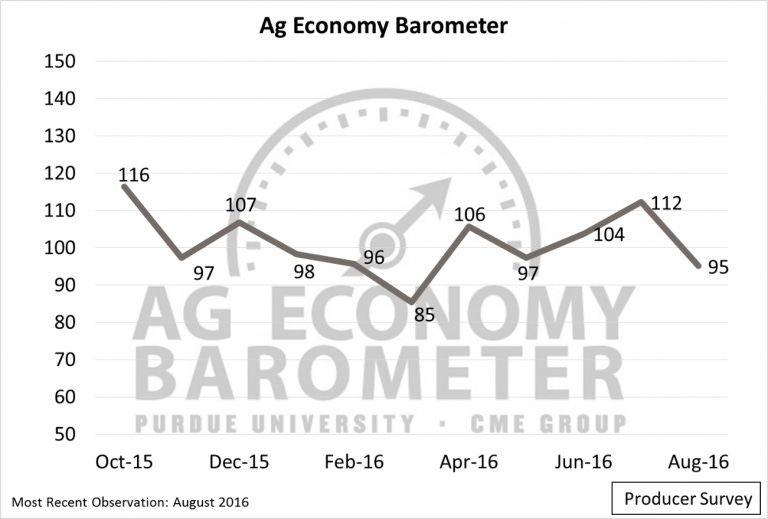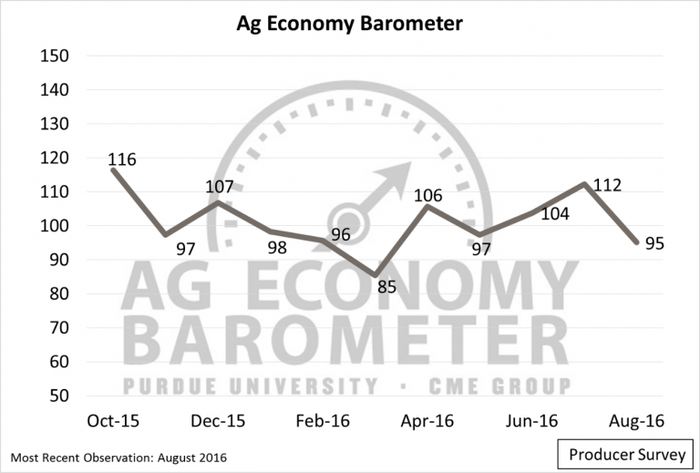Producers expect input costs to increase in 2017.

After months of increases in producer sentiment toward the U.S. agricultural economy, the August reading of the Purdue/CME Group "Ag Economy Barometer" showed that declining commodity prices are weighing on the minds of producers.
Producer sentiment declined sharply to 95, a 17-point drop from the July reading. The barometer is based on a monthly survey of 400 U.S. agricultural producers and includes measures of sentiment toward current conditions and future expectations.
The Index of Current Conditions fell from 93 in July to 80 in August, while the Index of Future Expectations dropped to 102 from July's 121.

"This was in sharp contrast to July, when farmers' optimism about future prospects pushed the barometer up, despite their concerns about current economic conditions," said Jim Mintert, the barometer's principal investigator and director of Purdue's Center for Commercial Agriculture.
According to Mintert, farmer sentiment in late spring and early summer was buoyed by a spring rally in key commodity prices, but near-ideal growing conditions for corn and soybeans this summer helped push yield prospects up and crop prices down sharply.
Since the peak of the price rally in mid-June, December 2016 corn futures have fallen by more than $1/bu. and November soybean futures by $1.75/bu.
The U.S. Department of Agriculture indicated in its August “Crop Production” report that record corn and soybean yields are expected this fall. If that's the case, carryover stocks for both crops will grow, potentially resulting in the lowest corn prices in a decade.
Unsurprisingly, the resulting tighter operating margins are leading to adjustments in production costs, said David Widmar, senior research associate who works on the barometer.
"What is somewhat surprising is that more producers expect input prices to rise in 2017 than decline," he said. "This was especially true for crop protection products, as nearly one-third of respondents expected prices to increase for herbicides, insecticides and fungicides."
Looking to 2017
Tight operating margins for crop producers are leading to adjustments in production costs, according to the latest report.
The Purdue crop budgets for rotation corn reported a $47-per-acre reduction in variable costs (seed, fertilizer, herbicides, etc.) from 2015 to 2016. Furthermore, a recent Purdue survey of Indiana farmland values and cash rents found that cash rents, on average, decreased 9.8% to 10.9 across the state from 2015 to 2016.
This summer’s crop price declines indicate that crop production margins will be even tighter in 2017 than in 2016, leading to questions about the direction production costs will take in the year ahead, according to the authors.
In the August "Ag Economy Barometer" survey, producers were asked about their expectations regarding changes in key input prices (seed, fertilizer, crop protection, etc.) for 2017 versus this year. More producers expect input prices to rise than decline in 2017. This was especially true for crop protection products as nearly one-third of respondents expect prices for herbicides, insecticides and fungicides to rise, compared to just over 10% of respondents who expect these input prices to decline.
“The long-term trend for crop input prices to rise seems to be leading to skepticism regarding prospects for input prices to decline, despite the lack of profitability among crop producers,” the report said.
About the Author(s)
You May Also Like

.png?width=300&auto=webp&quality=80&disable=upscale)

